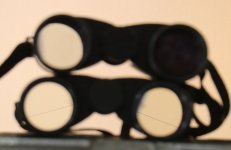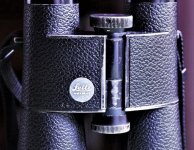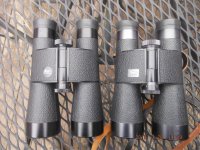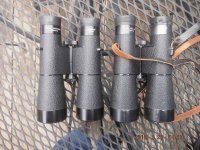On a gloomy rainy day, it's nice to sit inside and write my maiden message on BF. Here goes.
I have owned a Leitz Trinovid 8x32B (130m)(Wetzlar) since I bought them new in 1975. At various times since I have had or still have a 8x32B (130m)(Portugal), 8x32 (150m)(Wetzlar), a 10x40B (Portugal), etc., not to mention several Swarovskis, a Hensoldt Dialyt, and a couple Zeiss. So I'm an binocular excessive, perhaps!
I still love my original 8x32B Leitz binocs, and would like to understand a couple of details. It has been often said on this forum that going from the non-B to the B models, Leitz made "minor optical changes" that resulted in more eye relief, but reduced FOV. It is said without qualification that the Leitz (not Leica) Trinovids used the Uppendahl prism system. I wonder if this is true.
If you look into the objective end of these binocs, in the non-B models you see a very fine diagonal line, but not in the B models. Does this not suggest a fundamentally different prism system? (In my photo, the B-model (130m) is atop the non-B (150m) Trinovid.)
I have carried my original 8x32B binocs in my pack thousands of miles, even while owning supposedly "superior" instruments. The reason, of course, is the extreme small size and light weight. I love my Swarovski 8x32 EL, and 8.5x42 EL binocs, but when weight is at a premium, the Leitz are in my pack.
To me, phase coatings etc. are far less important factors in usability that size, weight, sharpness, contrast, minimum focusing range. Only considering binocs of the sort named here, size and weight are supremely important. Only in the most difficult seeing conditions (watching birds in very low contrast situations at twilight, for example) do I think my Swarovski 8.5x42ELs really shine. The Swaro 8x32 are totally lovely, but where I really notice their superiority is their minimum focus range (2m measured, vs 6m of my Leitz Wetzlar 8x32B)
If I understand it, the Trinovids originally came with hard rubber eyecups, then (as my 8x32 non-B) with short flexible rubber eyecups, and finally the B-models came with longer rubber eyecups. For me, this is all fairly academic, because now that I wear bifocal eyeglasses, no binoc is satisfactory while wearing the glasses. With single focal length eyeglasses, the Swaro retractable system is the best I've tried. Incidentally, I have seen mention here of 10, 14, and 17mm eyecups. How is this measured? Measuring the inside depth from the end of the cup to the horizontal rubber surface beside the lens, and on the outside from the end of the cup to where the rubber meets the metal ring, on my non-B , 5.4 and 9.43 mm; on my B model, 9.0 and 14 mm.
Finally, a really trivial question. It seems that the logo on the front of the old Trinovids is rectangular or round & black when from Wetzlar, but round & red when from Portugal. Does the red dot on the ring with serial number mean anything, since it is on binocs from both countries?
It's still raining.
I have owned a Leitz Trinovid 8x32B (130m)(Wetzlar) since I bought them new in 1975. At various times since I have had or still have a 8x32B (130m)(Portugal), 8x32 (150m)(Wetzlar), a 10x40B (Portugal), etc., not to mention several Swarovskis, a Hensoldt Dialyt, and a couple Zeiss. So I'm an binocular excessive, perhaps!
I still love my original 8x32B Leitz binocs, and would like to understand a couple of details. It has been often said on this forum that going from the non-B to the B models, Leitz made "minor optical changes" that resulted in more eye relief, but reduced FOV. It is said without qualification that the Leitz (not Leica) Trinovids used the Uppendahl prism system. I wonder if this is true.
If you look into the objective end of these binocs, in the non-B models you see a very fine diagonal line, but not in the B models. Does this not suggest a fundamentally different prism system? (In my photo, the B-model (130m) is atop the non-B (150m) Trinovid.)
I have carried my original 8x32B binocs in my pack thousands of miles, even while owning supposedly "superior" instruments. The reason, of course, is the extreme small size and light weight. I love my Swarovski 8x32 EL, and 8.5x42 EL binocs, but when weight is at a premium, the Leitz are in my pack.
To me, phase coatings etc. are far less important factors in usability that size, weight, sharpness, contrast, minimum focusing range. Only considering binocs of the sort named here, size and weight are supremely important. Only in the most difficult seeing conditions (watching birds in very low contrast situations at twilight, for example) do I think my Swarovski 8.5x42ELs really shine. The Swaro 8x32 are totally lovely, but where I really notice their superiority is their minimum focus range (2m measured, vs 6m of my Leitz Wetzlar 8x32B)
If I understand it, the Trinovids originally came with hard rubber eyecups, then (as my 8x32 non-B) with short flexible rubber eyecups, and finally the B-models came with longer rubber eyecups. For me, this is all fairly academic, because now that I wear bifocal eyeglasses, no binoc is satisfactory while wearing the glasses. With single focal length eyeglasses, the Swaro retractable system is the best I've tried. Incidentally, I have seen mention here of 10, 14, and 17mm eyecups. How is this measured? Measuring the inside depth from the end of the cup to the horizontal rubber surface beside the lens, and on the outside from the end of the cup to where the rubber meets the metal ring, on my non-B , 5.4 and 9.43 mm; on my B model, 9.0 and 14 mm.
Finally, a really trivial question. It seems that the logo on the front of the old Trinovids is rectangular or round & black when from Wetzlar, but round & red when from Portugal. Does the red dot on the ring with serial number mean anything, since it is on binocs from both countries?
It's still raining.







